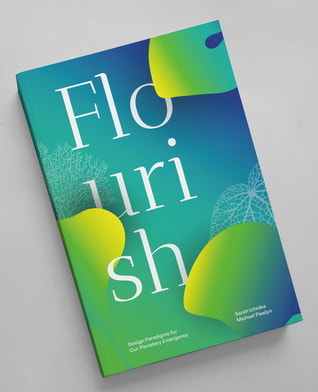“read this book...” “I love this book...” “a beautiful curation of ideas...” “ I highly recommend it...” “A brilliant and timely summary...”
see more reviews of Flourish below
see more reviews of Flourish below
High Praise for Flourish"I could not have hoped to start 2022 with a more inspiring read..."
Kate Raworth, Economist, Change Agent, Author: Doughnut Economics “I love this book – partly because of the voice that the authors have given it - more like a conversation than a lecture, in spite of its considerable authenticity. It feels perfectly timed too, following a COP that barely scratched the surface of what needs to be grasped in both hands. This tells it like it is, but without stomping the table in anger - true to the Donella Meadows way.”
Mike Cook, Visiting Professor Imperial College London + 2020 Institute of Structural Engineers' Gold Medal winner "If you're a designer, architect or anyone else who is wondering what you could - and should - do to arrest the climate emergency and all the other major threats we face, read this book - Flourish: Design Paradigms For Our Planetary Emergency".
Alice Rawsthorn OBE, design critic, author + co-founder, the Design Emergency project "When it comes to sustainability and the built environment, we have reached that moment when it is time to quiet the noise, put our ears to the ground and listen deeply to the ’thump’ of the Earth to know what we must do. Flourish gifts us a beautiful curation of ideas to help us hear that beat, + feel inspired to walk a different route towards creating human habitats that restore and replenish our living systems.”
Sumi Dhanarajan, Associate Director APAC, Forum for the Future. “One of the most enjoyable and informative reads on the topic. I highly recommend it to all those who are engaged with the agenda of the environment and who are in search of new paradigms to reverse the ongoing depletion of our living world.”
Dr Hossein Rezai (Founding Director, Web Structures; Global Design Director, Ramboll “A brilliant and timely summary of regenerative practice, aimed at everyone involved in shaping the built environment. Essential reading for designers, commissioners, funders and policy makers.”
Steve Tompkins, MBE, Director, Haworth Tompkins; co-founder, Architects Declare From Bloomberg 8th January, 2022:
The Architecture of Tomorrow Mimics Nature to Cool the Planet It’s not just about minimizing environmental harm, but finding ways to regenerate construction materials and restore natural habitats. There’s a new climate push in the building industry: regenerative architecture. The sector has been trying for years to cut its sizeable carbon footprint, which was responsible for 38% of the world’s energy-related greenhouse gases in 2019. But developers need to go beyond preventing pollution if they want to help avoid catastrophic climate change, according to Sarah Ichioka and Michael Pawlyn, co-authors of a new book titled Flourish: Design Paradigms for Our Planetary Emergency. They argue that buildings should be designed in a regenerative way — a process that mimics nature by restoring its own materials and sources of energy. It goes further than sustainable design, which seeks to reduce harm to the environment and use only essential materials. “More than half of humanity’s total historic greenhouse-gas emissions have occurred since the concept of ‘sustainability’ entered the mainstream,” Ichioka and Pawlyn write. “It is now time to embrace a new regenerative approach to design and development.” Their book highlights examples of regenerative design from China to Japan and the Democratic Republic of the Congo. Projects are still rare, but they’re a glimpse of what the future of rural and urban architecture could be." Read the full review |
Flourish:
|

